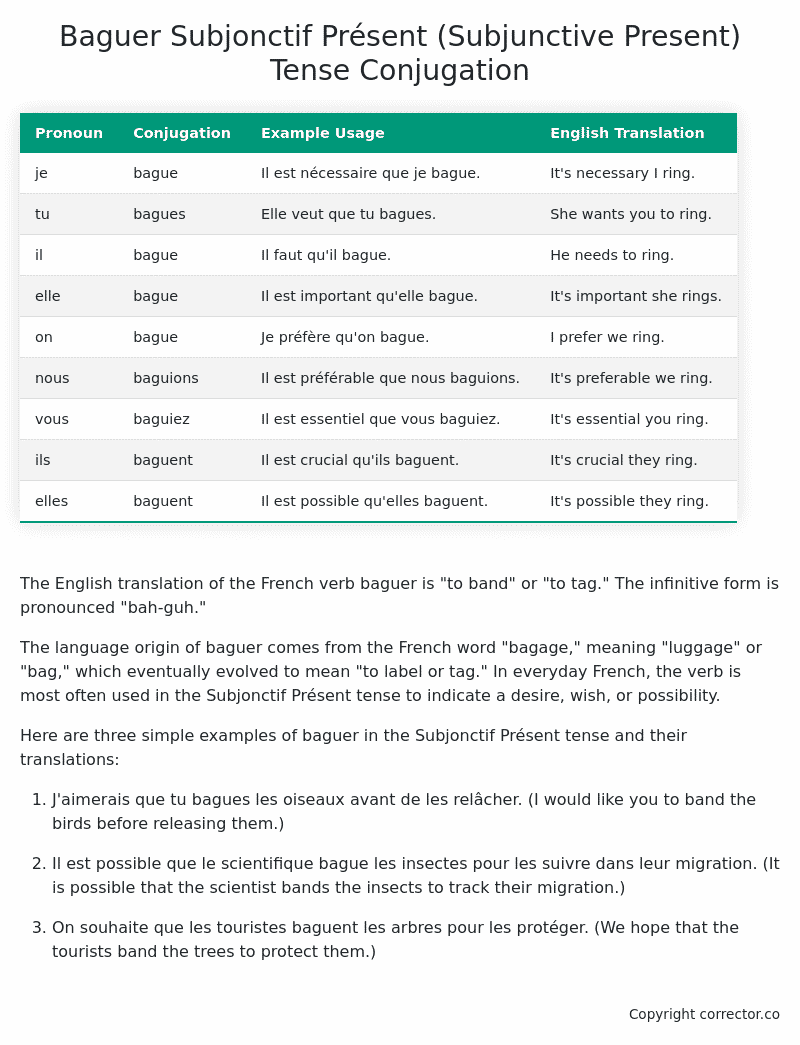Subjonctif Présent (Subjunctive Present) Tense Conjugation of the French Verb baguer
Introduction to the verb baguer
The English translation of the French verb baguer is “to band” or “to tag.” The infinitive form is pronounced “bah-guh.”
The language origin of baguer comes from the French word “bagage,” meaning “luggage” or “bag,” which eventually evolved to mean “to label or tag.” In everyday French, the verb is most often used in the Subjonctif Présent tense to indicate a desire, wish, or possibility.
Here are three simple examples of baguer in the Subjonctif Présent tense and their translations:
-
J’aimerais que tu bagues les oiseaux avant de les relâcher. (I would like you to band the birds before releasing them.)
-
Il est possible que le scientifique bague les insectes pour les suivre dans leur migration. (It is possible that the scientist bands the insects to track their migration.)
-
On souhaite que les touristes baguent les arbres pour les protéger. (We hope that the tourists band the trees to protect them.)
Table of the Subjonctif Présent (Subjunctive Present) Tense Conjugation of baguer
| Pronoun | Conjugation | Example Usage | English Translation |
|---|---|---|---|
| je | bague | Il est nécessaire que je bague. | It’s necessary I ring. |
| tu | bagues | Elle veut que tu bagues. | She wants you to ring. |
| il | bague | Il faut qu’il bague. | He needs to ring. |
| elle | bague | Il est important qu’elle bague. | It’s important she rings. |
| on | bague | Je préfère qu’on bague. | I prefer we ring. |
| nous | baguions | Il est préférable que nous baguions. | It’s preferable we ring. |
| vous | baguiez | Il est essentiel que vous baguiez. | It’s essential you ring. |
| ils | baguent | Il est crucial qu’ils baguent. | It’s crucial they ring. |
| elles | baguent | Il est possible qu’elles baguent. | It’s possible they ring. |
Other Conjugations for Baguer.
Le Present (Present Tense) Conjugation of the French Verb baguer
Imparfait (Imperfect) Tense Conjugation of the French Verb baguer
Passé Simple (Simple Past) Tense Conjugation of the French Verb baguer
Passé Composé (Present Perfect) Tense Conjugation of the French Verb baguer
Futur Simple (Simple Future) Tense Conjugation of the French Verb baguer
Futur Proche (Near Future) Tense Conjugation of the French Verb baguer
Plus-que-parfait (Pluperfect) Tense Conjugation of the French Verb baguer
Passé Antérieur (Past Anterior) Tense Conjugation of the French Verb baguer
Futur Antérieur (Future Anterior) Tense Conjugation of the French Verb baguer
Subjonctif Présent (Subjunctive Present) Tense Conjugation of the French Verb baguer (this article)
Subjonctif Passé (Subjunctive Past) Tense Conjugation of the French Verb baguer
Subjonctif Imparfait (Subjunctive Imperfect) Tense Conjugation of the French Verb baguer
Subjonctif Plus-que-parfait (Subjunctive Pluperfect) Tense Conjugation of the French Verb baguer
Conditionnel Présent (Conditional Present) Tense Conjugation of the French Verb baguer
Conditionnel Passé (Conditional Past) Tense Conjugation of the French Verb baguer
L’impératif Présent (Imperative Present) Tense Conjugation of the French Verb baguer
L’infinitif Présent (Infinitive Present) Tense Conjugation of the French Verb baguer
Struggling with French verbs or the language in general? Why not use our free French Grammar Checker – no registration required!
Get a FREE Download Study Sheet of this Conjugation 🔥
Simply right click the image below, click “save image” and get your free reference for the baguer Subjonctif Présent tense conjugation!

Baguer – About the French Subjonctif Présent (Subjunctive Present) Tense
Formation of the Subjonctif Présent
Common Everyday Usage Patterns
Interactions with Other Tenses
Summary
I hope you enjoyed this article on the verb baguer. Still in a learning mood? Check out another TOTALLY random French verb conjugation!


